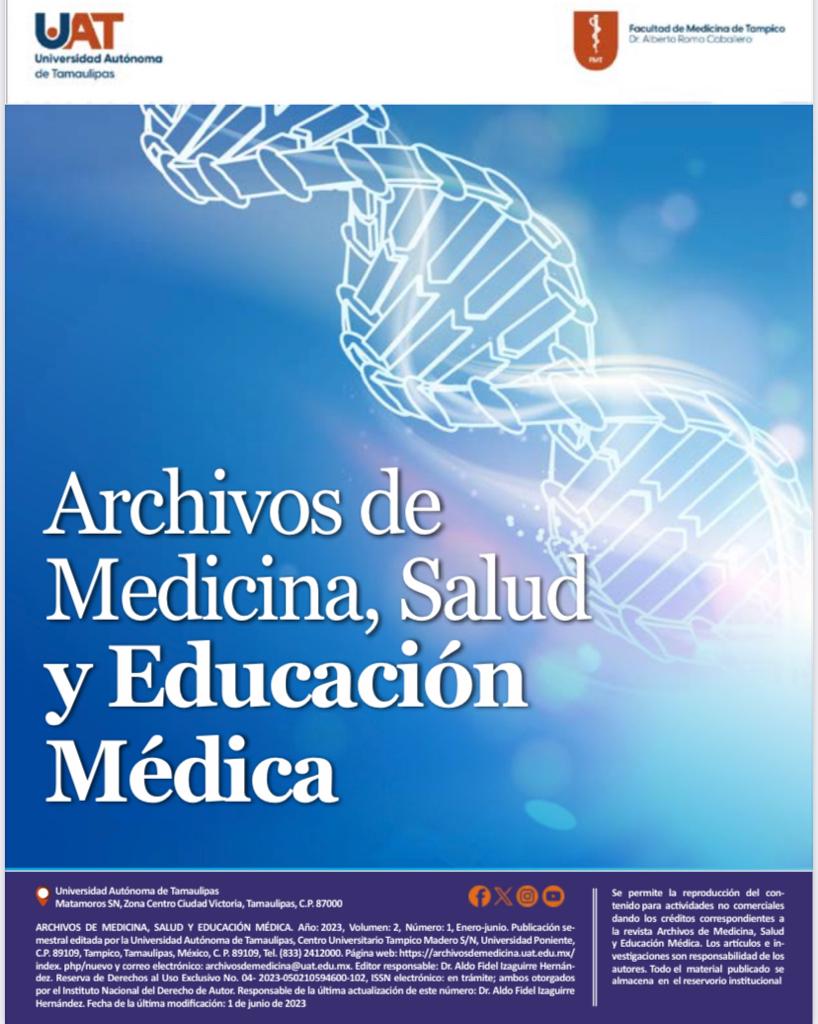Correlación entre cociente proteína/creatinina y proteinuria en orina de 24 horas en pacientes embarazadas con sospecha de preeclampsia en el Hospital Regional Cd. Madero
DOI:
https://doi.org/10.29059/amsem.v2i1.53Abstract
Preeclampsia is one of the frequent, serious complications of pregnancy; with a high fetal maternal morbidity and mortality; For this reason, it is important to find diagnostic tools that allow us to detect it and initiate appropriate treatments in a timely manner. proteinuria is one of the criteria that can be part of the diagnosis, but is not necessary when damage to a target organ is demonstrated. Among the diagnostic tests to detect proteinuria in urine is the 24-hour urine collection with the measurement of proteins greater than 300 mg; but currently other tests with less technical complexity have been found that can help diagnosis, such as the protein/creatinine index; which can help detect proteinuria in a single urine sample; Therefore, it is important to know if there is a good correlation between the two. The objective of this study was to determine the correlation between the protein/creatinine ratio and 24-hour urine proteinuria in pregnant patients with suspected preeclampsia at the Cd. Madero Regional Hospital. 24-hour urine protein and protein/creatinine ratio were analyzed in pregnant patients more than 20 weeks' gestation with blood pressure 140/90 mmHg or higher, in whom preeclampsia is suspected; with the collection is assessed in a study of correlation of quantitative variables in the NCSS system 11. From the assessment of 51 patients with suspected preeclampsia, a Pearson coefficient of 0.3279 with a p of 0.0188 (95% confidence interval) was obtained. 0.0566 – 0.5535). Whether there is a statistically significant correlation between the protein/creatinine ratio and 24-hour urine protein; with which the index could be used as a timely diagnostic test for suspicion of preeclampsia, reducing the technical difficulties of 24-hour urine collection.
References
ACOG American College of Obstetricians and Gynecologists. (2019). Practice bulletin no. 202: gestational hypertension and preeclampsia. Obstet Gynecol, 133(1), e1-e25.
Baba, Y., Yamada, T., Obata-Yasuoka, M., Yasuda, S., Ohno, Y., Kawabata, K., ... & Minakami, H. (2015). Urinary protein-to-creatinine ratio in pregnant women after dipstick testing: prospective observational study. BMC pregnancy and childbirth, 15, 1-7.
Bello, N. A., Zhou, H., Cheetham, T. C., Miller, E., Getahun, D., Fassett, M. J., & Reynolds, K. (2021). Prevalence of hypertension among pregnant women when using the 2017 American College of Cardiology/American Heart Association blood pressure guidelines and association with maternal and fetal outcomes. JAMA network open, 4(3), e213808-e213808.
Berhan, Y. (2016). No hypertensive disorder of pregnancy; no preeclampsia-eclampsia; no gestational hypertension; no hellp syndrome. Vascular disorder of pregnancy speaks for all. Ethiopian journal of health sciences, 26(2), 179-188.
Brown, M. A., Lindheimer, M. D., de Swiet, M., Assche, A. V., & Moutquin, J. M. (2001). The classification and diagnosis of the hypertensive disorders of pregnancy: statement from the International Society for the Study of Hypertension in Pregnancy (ISSHP). Hypertension in pregnancy, 20(1), ix-xiv.
Duley, L. (2009, June). The global impact of pre-eclampsia and eclampsia. In Seminars in perinatology (Vol. 33, No. 3, pp. 130-137). WB Saunders.
Erez, O., Romero, R., Jung, E., Chaemsaithong, P., Bosco, M., Suksai, M., & Gotsch, F. (2022). Preeclampsia and eclampsia: the conceptual evolution of a syndrome. American journal of obstetrics and gynecology, 226(2), S786-S803.
Helewa, M. E., Burrows, R. F., Smith, J., Williams, K., Brain, P., & Rabkin, S. W. (1997). Report of the Canadian Hypertension Society Consensus Conference: 1. Definitions, evaluation and classification of hypertensive disorders in pregnancy. Cmaj, 157(6), 715-725.
Kallela, J., Jääskeläinen, T., Kortelainen, E., Heinonen, S., Kajantie, E., Kere, J., ... & Laivuori, H. (2016). The diagnosis of pre-eclampsia using two revised classifications in the Finnish Pre-eclampsia Consortium (FINNPEC) cohort. BMC pregnancy and childbirth, 16(1), 1-7.
Magee, L. A., Nicolaides, K. H., & Von Dadelszen, P. (2022). Preeclampsia. New England Journal of Medicine, 386(19), 1817-1832.
Pasternak, Y., Lifshitz, D., Shulman, Y., Hiersch, L., Rimon, E., Kuperminc, M., ... & Ashwal, E. (2021). Diagnostic accuracy of random urinary protein-to-creatinine ratio for proteinuria in patients with suspected pre-eclampsia. Archives of Gynecology and Obstetrics, 304, 109-115.
Sibai, B. M. (2003). Diagnosis and management of gestational hypertension and preeclampsia. Obstetrics & Gynecology, 102(1), 181-192.
Sibai, B. M. (2004). Diagnosis, controversies, and management of the syndrome of hemolysis, elevated liver enzymes, and low platelet count. Obstetrics & Gynecology, 103(5 Part 1), 981-991.
Stout, M. J., Scifres, C. M., & Stamilio, D. M. (2013). Diagnostic utility of urine protein-to-creatinine ratio for identifying proteinuria in pregnancy. The Journal of Maternal-Fetal & Neonatal Medicine, 26(1), 66-70.
Valdés, E., Sepúlveda-Martínez, Á., Tong, A., Castro, M., & Castro, D. (2016). Assessment of protein: creatinine ratio versus 24-hour urine protein in the diagnosis of preeclampsia. Gynecologic and Obstetric Investigation, 81(1), 78-83.
Whelton, P. K., Carey, R. M., Aronow, W. S., Casey, D. E., Collins, K. J., Dennison Himmelfarb, C., ... & Jones, D. W. (2018). Guideline for the prevention, detection, evaluation, and management of high blood pressure in adults: executive summary: a report of the American College of Cardiology/American Heart Association Task Force on Clinical Practice Guidelines. Hypertension, 71(6), 1269-1324.
Yoder, S. R., Thornburg, L. L., & Bisognano, J. D. (2009). Hypertension in pregnancy and women of childbearing age. The American journal of medicine, 122(10), 890-895.
Downloads
Published
How to Cite
Issue
Section
License
ARCHIVOS DE MEDICINA,SALUD Y EDUCACIÓN MÉDICA by Universidad Autónoma de Tamaulipas is licensed under a Creative Commons Reconocimiento-CompartirIgual 4.0 Internacional License.
ARCIVOS DE MEDICINA, SALUD Y EDUCACIÓN MÉDICA es una revista digital de acceso abierto (OJS) y editada por la Universidad Autónoma de Tamaulipas, con publicación semestral Sitio web: ... Director de la revista:... Reserva de Derechos al Uso Exclusivo No..... otorgados por el Instituto Nacional del Derecho de Autor (INDAUTOR). Responsable de la última actualización Dr. José Alberto Ramírez de León, con domicilio en calle Matamoros S/N Zona Centro, C.P. 87000 Ciudad Victoria, Tamaulipas, México. Tels. (834) 3181800 y 3181700, ext 1148..







